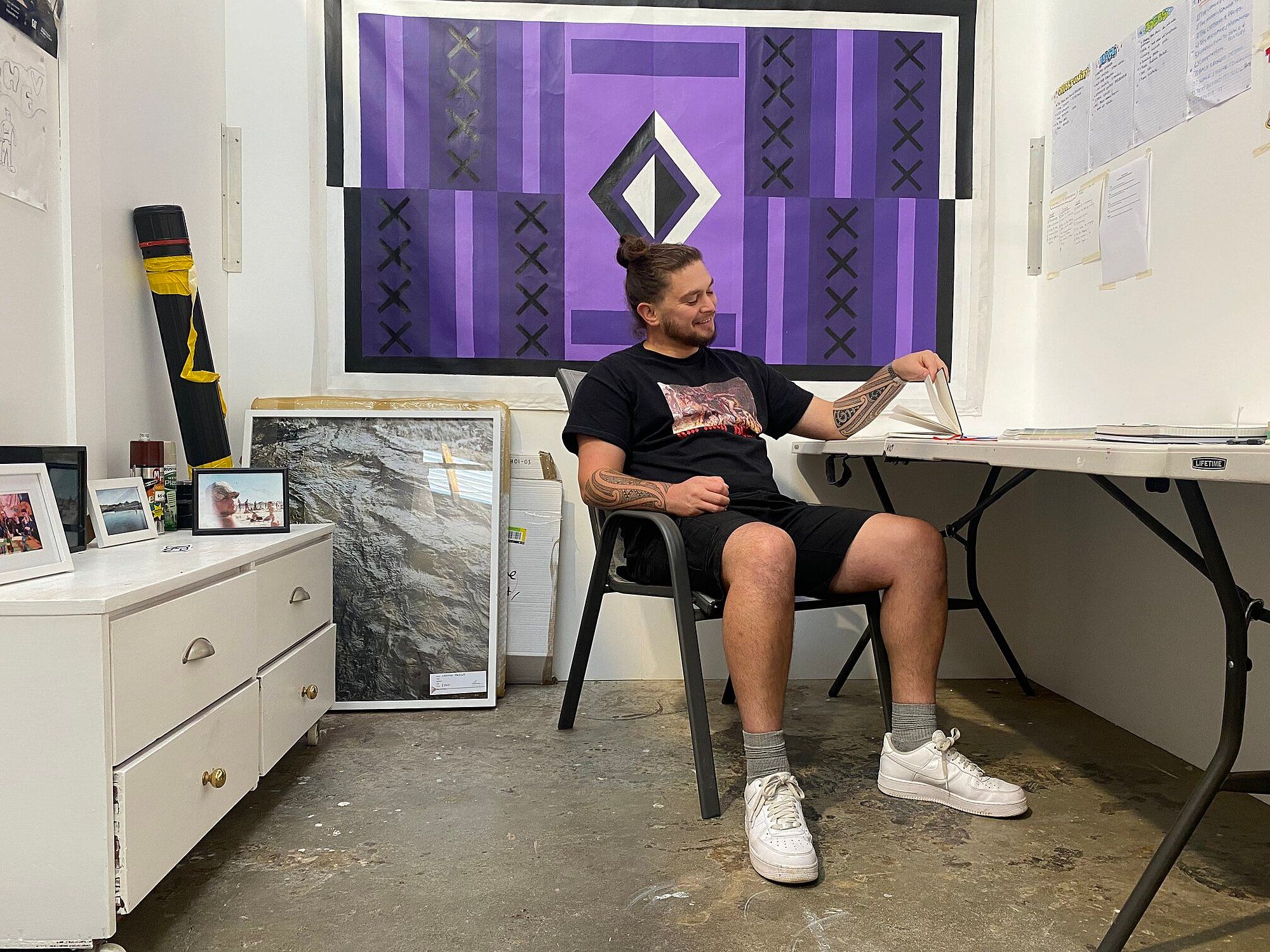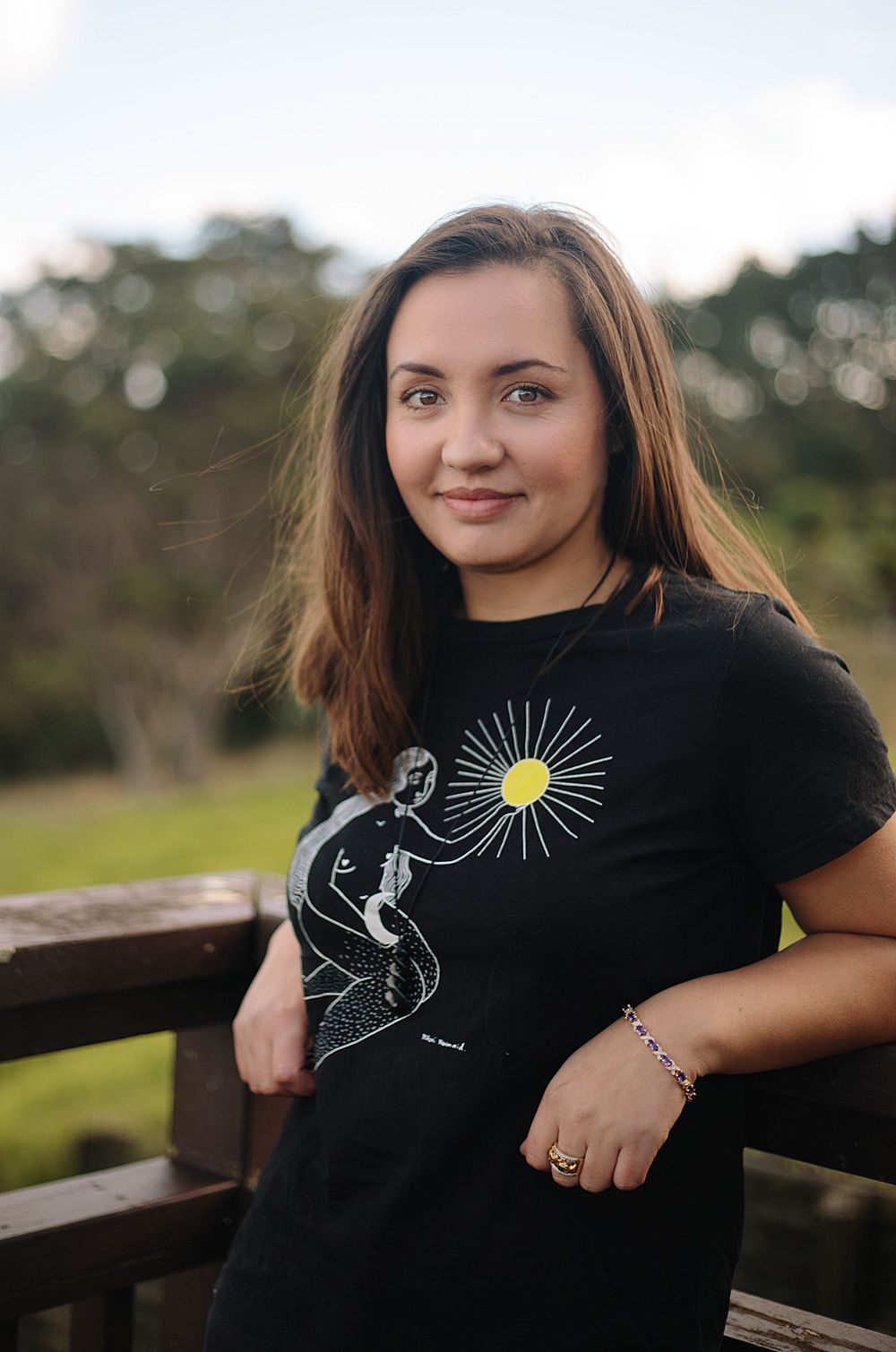Off the Beaten Track: Chevron Hassett
Editor Ataria Sharman with Chevron Hassett on taking the time for self-care and refining his art practice.
Picking up a takeaway latte in Whangārei led to a chance encounter with up-and-coming Māori artist Chevron Hassett (Ngāti Porou, Ngāti Rongomaiwahine, Airihi). Chevron (Chev) is from Te Awakairangi, and the last I’d heard, he was still living in Pōneke, so it was surprising to see him in Te Tai Tokerau, 12 hours away. We chatted, and then I crashed his breakfast. After Chev made sure I was okay with him eating in front of me, we sat together. I learnt that Chev had recently moved to Te Tai Tokerau and made my local, Sabio Café, his local too. The next Off the Beaten Track was born.
Ataria Sharman: Chev, I’m glad I’ll be seeing more of you around Whangārei. I’d love to know how you describe your own art practice.
Chevron Hassett: My earliest work was with lens-based media, sculpture and public installation, with an interest in cultural identity and Indigenous urbanisation. This is the kaupapa I mainly focus on in my art, and it stems from my own background as someone who grew up in an urban Māori community. My family is one of many who run the urban marae Koraunui in Stokes Valley, Wellington, and most of my childhood was spent there. At the time, I thought it was normal to be raised up on an urban marae, and it’s something I feel I have strength in representing – someone who didn’t grow up on their homelands but in an urban Māori environment. Urbanisation is relatively new, too; it’s only been happening over the last 100 years.
I thought it was normal to be raised up on an urban marae, and it’s something I feel I have strength in representing
The research element of my work stems from my background in academic studies. I find that the medium of the pieces I create is informed by the research I do before I begin making. Instead of coming in with a predefined form, the themes that unfold from the research define the project’s form. I also try not to be solely academic in my art making and leave space for the spiritual aspects to come through, especially as someone with whakapapa Māori.
I still believe I have a lot of refining to do and haven't fully matured in my practice.
AS: What was it like growing up on an urban marae?
My dad’s Māori and my mum’s Pākehā. They split when I was young, and my mum remarried. I’m the oldest of my siblings and would visit my grandparents on my Māori side often. My grandad was really staunch; his job was teaching tikanga Māori in schools. I’d be at school, and he’d come in and do lessons. At a young age, they took us back to the marae that we whakapapa to all along the East Cape. They actively tried to teach and involve us.
The urban marae I grew up in, Koraunui, is run by women, including my nan
The urban marae I grew up in, Koraunui, is run by women, including my nan. The Koraunui community was really alive in the 1990s and early 2000s. It has a kōhanga and an alternative school on the grounds, too. I’d go to the marae once or twice a week, Wednesdays and Thursdays, with my cousins, and we’d learn things like taiaha.
Growing up in a community shaped my view of getting involved, and helping communities grow. I have a strong affinity for the groupings I come from. As I get older, I recognise more and more the power of community that my grandparents instilled in us.
AS: You mentioned that you haven’t fully matured in your practice. Do you think there ever will be a point where you have?
I don’t know if I will ever stop growing in what I want to make, particularly in skillset and the application of that, and how I can further an art form.
I’m taking this time in Whangārei to refine my practice, and slow down my lifestyle
I’m taking this time in Whangārei to refine my practice, and slow down my lifestyle. Back in Pōneke, it was go go go. I’d be in the studio all day and sometimes until 1am, even staying the night. Outside of work, too, I was socialising and into my hobbies; I was always doing something. I never slowed down.
Having just moved to Whangārei, the break I’m taking now is the first since finishing university five years ago. I feel like now I can take care of myself and my practice, and have more clarity around what I’m doing and why. That’s my focus at the moment.
It feels that the people I’m with daily have more understanding and sincerity for each other's space and energy. There’s more understanding of holistic wellbeing. I think part of that is because I’m in a Māori space
AS: What is it about Whangārei?
I’m not from here, so I can focus on myself instead of my community. When I am in Pōneke, I’m part of an intergenerational community, and some responsibilities come with that. I also had a studio in the city and was working there every day. It’s busier, and you’re exchanging your energy with a lot of people. Up here, it feels that the people I’m with daily have more understanding and sincerity for each other's space and energy. There’s more understanding of holistic wellbeing. I think part of that is because I’m in a Māori space.
The landscape in Whangārei is beautiful, the perfect landscape for taking care of yourself. It feels homely here on the east coast, on the Pacific Ocean, the same as where I’m from in Gisborne. There’s less to do here, which kind of forces you here to focus more on being at home and taking care of those sorts of things. I’m renting, and my partner and I can afford our own house, which wasn’t possible in Pōneke. I’m thinking more consciously about food and my diet, even looking to be more outdoorsy with hunting, fishing and gardening.
Chevron Hassett in his studio at Hihiaua Cultural Centre
AS: Where do you make your art now?
I have a studio at the Hihiaua Cultural Centre, next to the Hātea river in the Whangārei CBD. I was invited to be in that space by Justice Hetaraka. There are many whakairo artists in residence and well-respected people in the local community who have a lot of mana there. It’s a nice place to be involved with. It’s a privilege to be there.
AS: Do you have a daily routine or practices for your making process?
I’ve developed a new schedule since living here. I come to the studio five days a week, Monday to Friday. In Pōneke, it was Tuesday to Saturday. I do drawing exercises in the morning to get my brain working, and email admin.
Every week looks very different in terms of projects. Most of my time is spent developing concepts and communicating with design clients and art galleries. Although I can’t physically craft a lot of my work in the studio, I use the space for preparation and planning.
Kamilaroi artist Reko Rennie's illuminated text work Remember Me has been very influential in my practice
AS: Was your mahi affected by Covid-19?
It was. I was in Ahitereiria and had two residencies lined up, and three or four shows. When the pandemic happened, I decided to come back early, and then my grandad got sick, so I stayed here. In saying that, I feel like if I’d stayed over there, my practice would’ve developed quite differently from what it is now. I believe the energy of the place and the environment really does impact how I make work. Now that I’m out of Pōneke, I don’t feel so much that I’m only creating work in that city. I feel a bit more mentally spread out around the country.
We don’t talk enough here about international art. There’s a rich history of Māori artists doing well overseas, and I aspire to do that. Just seeing how they go about responding to issues and socially creating work was massive for my practice. After spending time in Ahitereiria, I came back with new ideas and ways of working. In my work Tū Tonu, I drew inspiration from Naarm-based Kamilaroi artist Reko Rennie. His illuminated text work Remember Me has been very influential in my practice, how the work was bold and powerful but held deep meaning. I’m keen to continue that research and development.
There’s a rich history of Māori artists doing well overseas, and I aspire to do that
AS: Who have been your biggest supporters or mentors?
A formal mentorship is something I’ve been wanting and working towards. I recently found out that I’ll be receiving the The Arts Foundation Springboard Award for Visual Arts, an award provided by the Edgar Family that includes a one-year mentorship with Brett Graham. This is a huge opportunity that I’m really exhilarated about, as I’ve recently got to meet Brett and he is an amazing person and artist. He’s made monumental mahi and shows, and I hope to just be a sponge around him. He’s been really kind and I believe it will be a meaningful mentorship.
AS: What’s next for you?
I have some mahi coming up with Te Tairāwhiti Arts Festival in June, where I’ll be making another light sculpture of text, which I am currently finalising. In early July, Melanie Baldwin has curated me into another public art project in Kaitī, which I am really excited about.
I hope to start doing projects with big pūtea so I can have more time for other projects that mean a lot to me
In July I also have a public art project supported by Creative New Zealand being installed in Lower Hutt, Wellington. There’ll be an iteration of that on the backs of buses. The project was a collaboration with students from Naenae College – through a teacher, Tia Pohatu – and from Taita College through youth mahi I did there. It's something I’ve been working on for a long time.
In August I am installing another public art project in the Hutt Hospital, which I was approached to do by Rawiri Hirini.
After that, I hope to have a break, slow down with shows, refine and build bodies of work, and learn new techniques. There are some personal projects I’m going to try to do as well – maybe some work for my mārae Ruawharo, in Mahia. I’d love to make art for the wharekai.
I hope to start doing big projects with big pūtea so I can have more time for other projects that mean a lot to me.
This interview has been edited for clarity and conciseness.


